How to plant a border like a pro
It’s time to plant a border.
This post is about planting a whole border. I’m not just going to stuff a few plants into the current bed. I’m starting again from scratch.
Of course, we may dream of glorious borders bursting with colour. We see them on TV programmes, in magazines, in professionally-run gardens…
But how can we achieve those brilliant, beautiful borders in our own gardens?
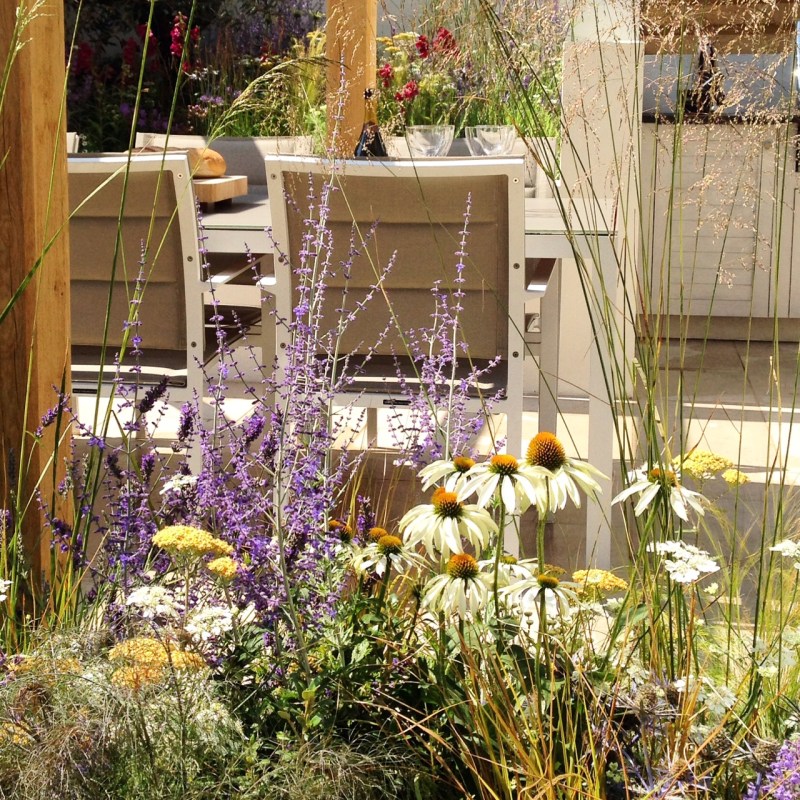
A show garden border. Hard to match such casually thrown-together perfection at home.
So I’ve been picking the brains of professional gardeners and have asked them how to plant a border.
This is what you need to know:
1) Show gardens aren’t real
They’re there to give you ideas and inspiration, not for you to copy.
Show garden borders are like the fashion pages of a magazine. They are stuffed full of plants that have been prinked and perked to perfection. Only planted for a few days at a time, they’re jammed together and treated as if they’re in intensive care. Show borders are often groups of pots, clustered so tightly together that you can’t see the pot.
If you’re planning to plant a border, don’t worry about whether it will look as good as a show garden. That’s not real gardening. It’s show-time. Enjoy it.
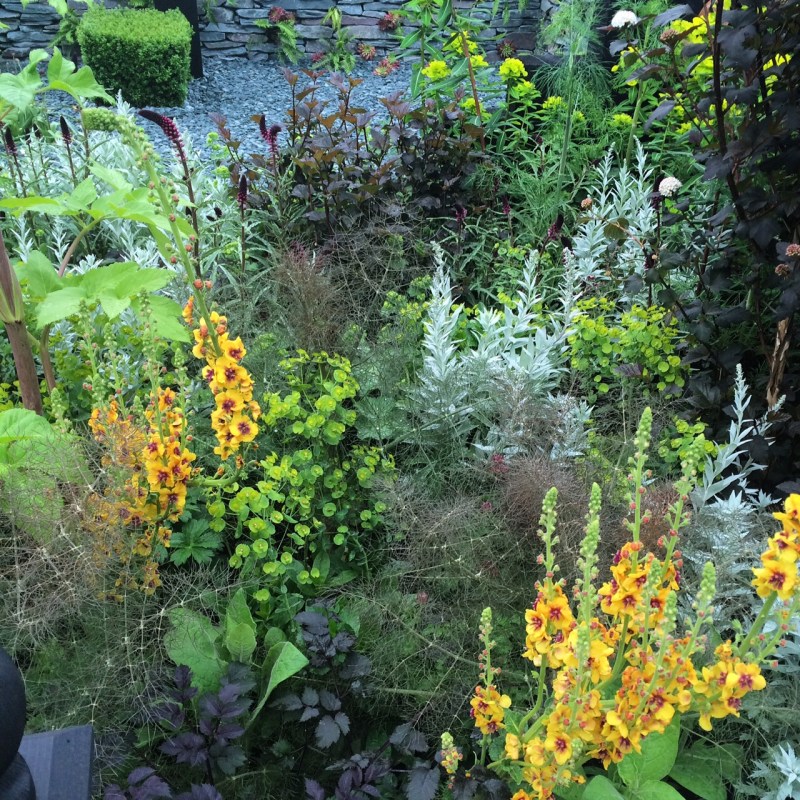
The winner of the Great British Garden challenge at the RHS Chelsea Flower Show a few years ago. Although it’s hard to reproduce a show garden, I think this use of colour is inspiring.

The Long Border at Great Dixter is one of the most famous borders in the world. But it is planted up by leading professional gardeners. You don’t need to feel bad about not achieving this level of perfection. Just enjoy the inspiration and the colours.
2) Do your prep!
If you decide to paint a room, the DIY books will tell you that preparation is 90% of the work. Good preparation really helps a border succeed too. Clear as much of the old border away as you can, weed thoroughly and apply a mulch of garden compost or well rotted manure.
There are more tips on how to prepare a border in Revamp a Border – 11 tips to turn scrappy into sensational.
One factor that’s increasingly important is plant resilience. In the UK – and elsewhere – we’ve had some very hot, dry summers, followed by bouts of unusually cold or wet weather. I can safely say that many of my gardening friends are reporting many more plant losses than usual! See here for a list of 10 resilient perennials that survive both very dry and very wet summers.
It’s also worth estimating the costs, too. Planting a border can be expensive, but I researched the eight best ways to create a border on a budget.
3) How to plant a border from scratch
First, check how much sunlight your border gets. The most common reason for plants not flowering is that they’re planted in the wrong place for the amount of sun they need. (For other reasons why your border plants aren’t flowering, see the 6 most common reasons why your garden plants aren’t flowering – and how to fix it.)
If your border has 6+ hours of sunlight a day in summer, it is ‘full sun’. Plant it with sun-loving plants.
Then think about the width and density of the plants as well as their height. This is particularly important when you are planting a border from scratch.
Borders used to be planted with the tallest plants at the back. You put towering 6ft blooms at the back and tiny 6″ flowers at the front.
Now it’s fashionable to have most of the planting at the same height. But the most important thing is to have a plan before you go shopping. You’ll get a better border, and you’ll save money. Don’t just set out to the garden centre to see what plants you like best. There’s more good expert advice here on how to plan a truly successful flower border.
Many garden designers now emphasise that it’s important to think about the overall shape of your plant and the colour of its foliage. In Naturalistic planting – how to get it right for your garden, Garden designer Michael McCoy says you should aim for contrast in plant shapes and foliage colours. ‘Then you can get away with almost anything when it comes to flower colour.’ See his and other garden designer tips in the best garden design advice of the year.
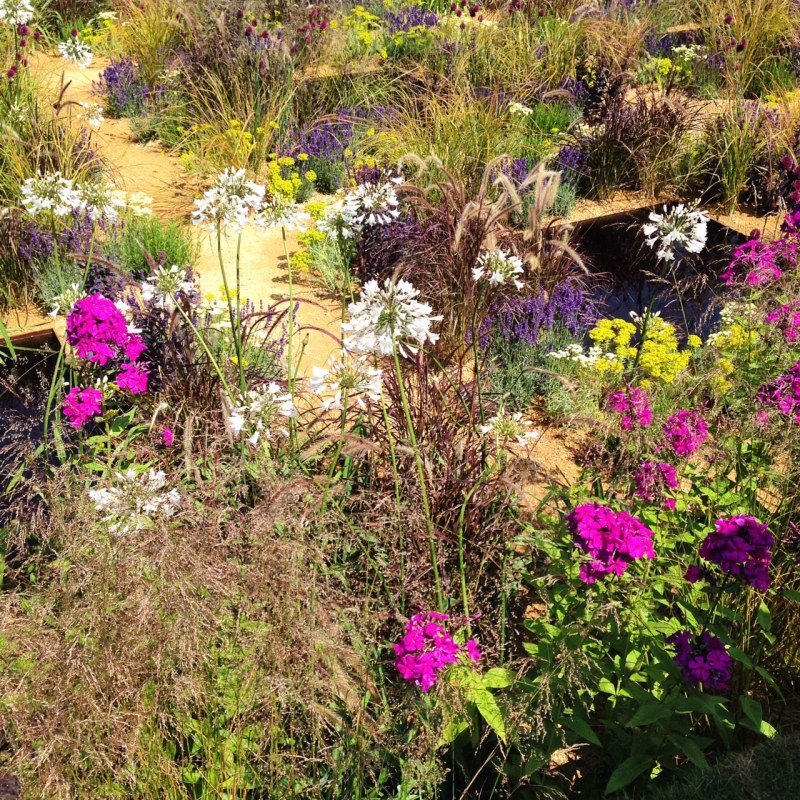
The One Show garden at Hampton Court. Planting is more or less at the same height. But plants are airy.
Whichever you choose, you need to give your plants the space to grow sideways. If the label says that the width is ultimately 30cm, you need to make sure it has 15cm on either side before you plant its mate.
But also think about how airy or dense each plant is, before you plant a border. I planted some phlox in the middle of my new border, with some verbascum behind.
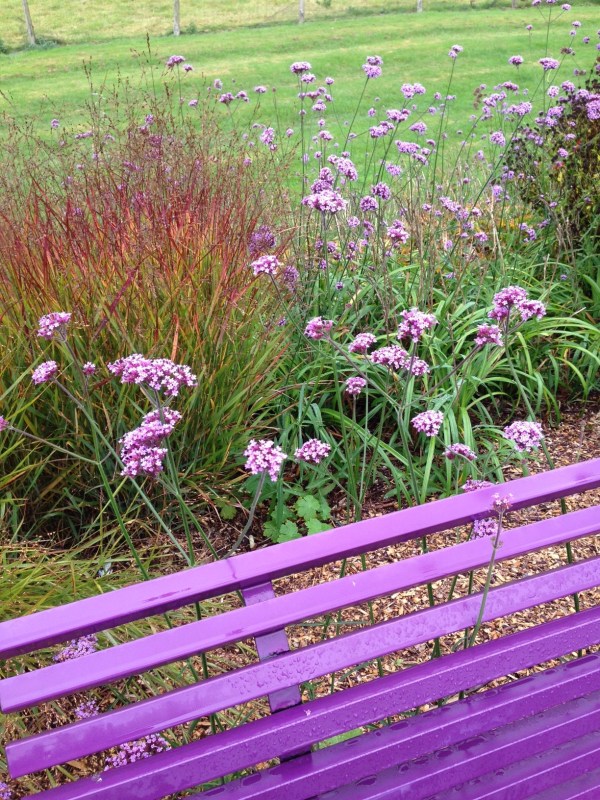
Planting at the Sussex Prairie Gardens. It’s airy and modern. Plants aren’t graded by height but are see-through.
‘You need the phlox towards the back,’ said garden consultant Posy Gentles. ‘It’s a very dense plant. Whereas the verbascum is a bit taller but it’s airy so you can see through it.’
Now I know why I never felt my penstemons looked right. They were no higher than the plants around them, but they sat in a solid chunk. They didn’t flow into the planting around them. I think I’d have liked them more if they’d been on the middle or at the back, rather than looming over the front and blocking everything behind them.
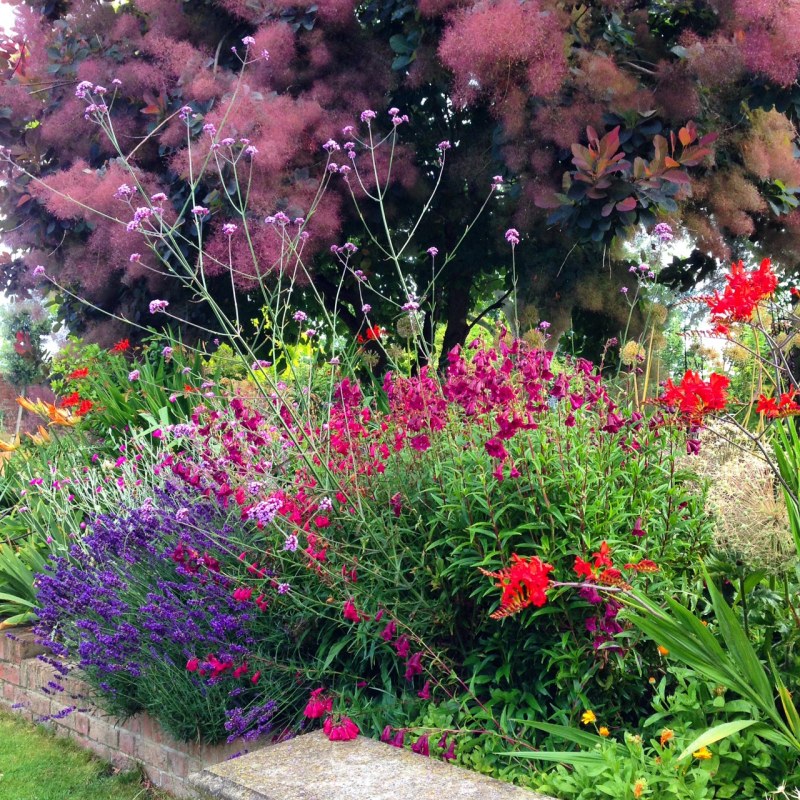
The penstemons (dark pink, centre) were too chunky at the front of my border.
But you don’t find anything out about plant density on the label. If you buy your plants from a nursery, you should be able to find someone who knows about horticulture who will help you.
Head gardener Tom Brown at the famous West Dean Gardens also has some good advice on planning a beautiful border here.
Or Google ‘plant name + images)’. Some of the pictures will show the whole plant.
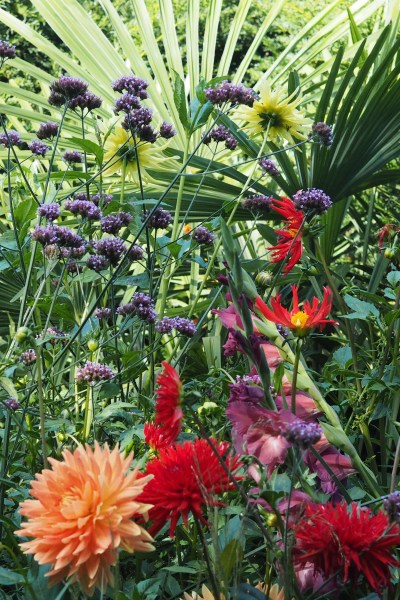
Here at Borde Hill Gardens in Sussex, you can see a tall airy flower (Verbena bonariensis), combined with the more solid block of dahlias, and contrasted with the architectural shapes of the big leaves behind.
4) How to plant a perennial border
Many perennials take more than a year to reach their best.
I’ve often bought plants from a nursery or garden centre, then been disappointed with their performance. But many herbaceous perennials won’t look their best the year you plant them.
They’ll be better next year. After that they’ll go on looking good for a few years. So don’t be discouraged if they don’t look interesting when you buy them.
My acanthus mollis ‘rue Ledan’, for example, has taken three years to find its feet, but it looks as if it’s going to be lovely this year.
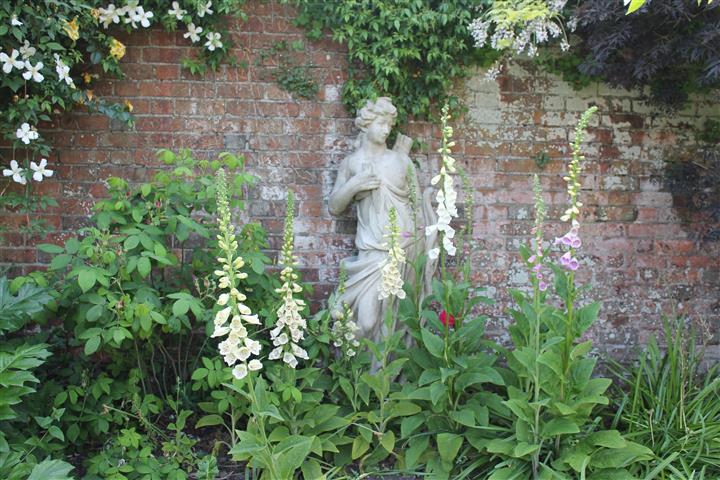
I planted an Acanthus mollis Rue Ledan (an all-white version of Bear’s britches) in front of this statue two years ago. But in this picture, it’s still just a clump of leaves. The foxgloves have kept the interest going while the acanthus finds its feet.
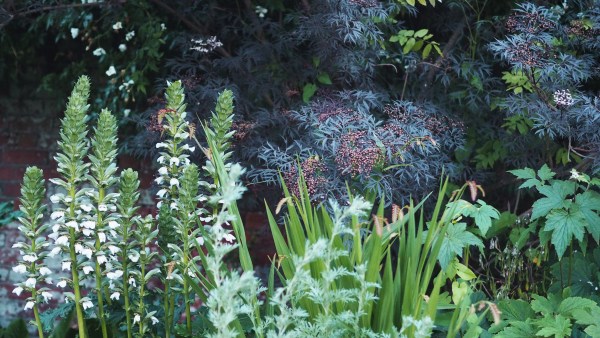
And here it is! Acanthus mollis ‘Rue Ledan’ three years after planting. I think it was worth the wait and I love it with the black leaves of Black Elder (Sambucus Nigra).
Find out how to choose the best plants for your garden in this post. It’s also worth choosing perennials that will flower for a long time or that will repeat flower. Here are six perennials that flower all summer from Doddington Place Gardens.
It’s also important to be realistic about whether your border is sunny or shady, too. If you’re planning a north-facing border, then read these posts on a shady north-facing garden, a shady difficult corner and a low maintenance shade border.
5) So fill your gaps with border annuals.
There’s a huge amount of snobbery about common annuals for borders.
But there are lots of attractive plants that will plump up your borders while the perennials get established. Posy thinks we should look at begonias again, and a massed planting of cosmos always looks fabulous.
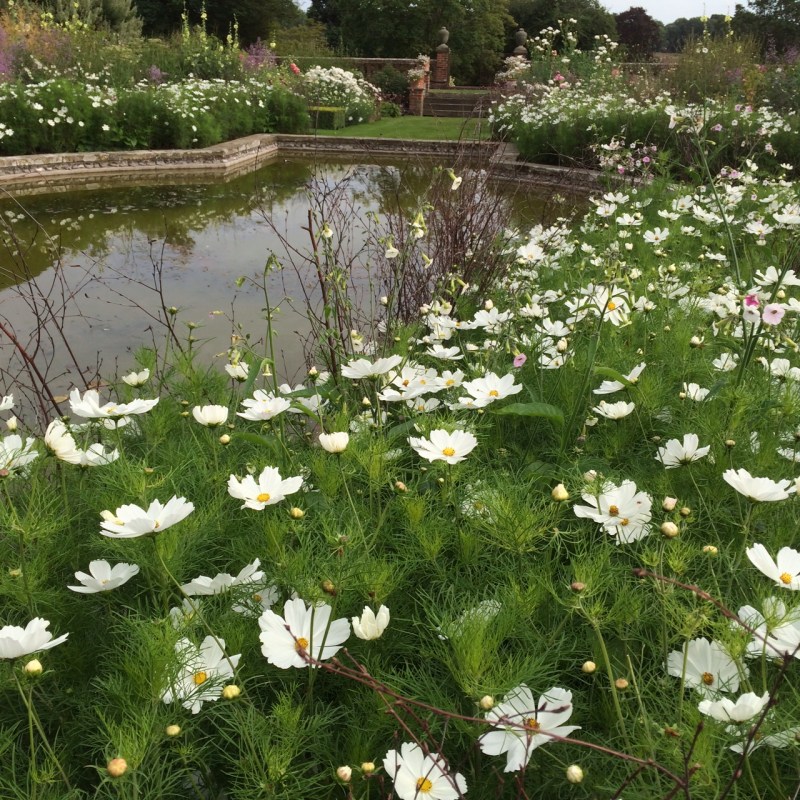
Massed cosmos annual planting in the Sunk Garden at Doddington Place Gardens
Cosmos, antirhinums, nicotiana, gazania, zinnias….annuals are rather colourful. Most also come in white.
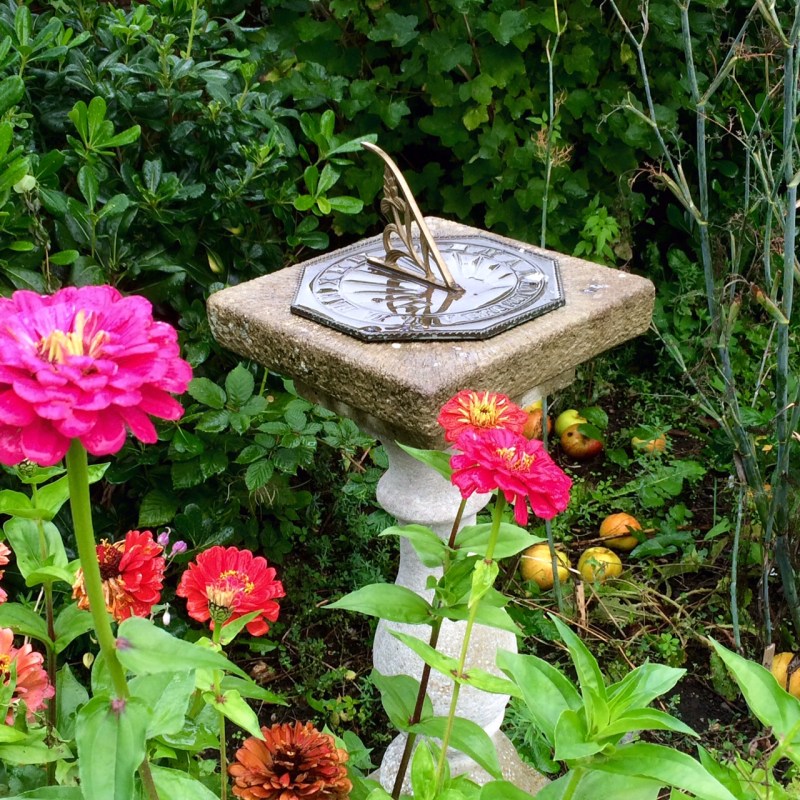
Zinnias are a useful and reliable annual.
For an inspiring look at an amateur gardener who fills her border with a mix of annuals and perennials, see this post on how to make a herbaceous border look amazing. Frances and Paul Moskovits spend a great deal of time and effort on their garden, but there are valuable tips for us all.
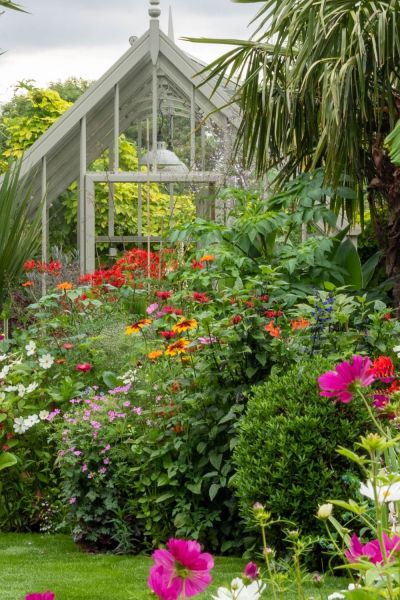
Paul and Frances Moskovits have a beautiful long herbaceous border. They keep it packed with flowers from spring to autumn. It’s a real example of what can be achieved in a middle-sized garden.
6) How many different plants do I need when I plant a border
This tip comes from horticultural and landscaping expert Matt Jackson. ‘Try to keep to just six different varieties of plants when you plant a border,’ he says. ‘This can look very good.’
It’s very difficult to stick to six, but the main point is that drifts or clumps with lots of the same kind of plants are more effective than planting just one or two of each plant.
‘Plant in threes or fives’ is the standard garden advice. Professional gardener Stephanie Wolfe has a pragmatic attitude: ‘I often plant in fours and sixes,’ she says. ‘Because one usually dies.’
Tom Brown, head gardener at West Dean Gardens in Sussex, advises planting in even larger clumps. ‘If you have a group of 5,7 or 9 plants, then if one or two die, you’ll still have a good grouping,’ he says.
All this means that there are quite a few different factors to think about when planning your border. So I’ve devised a Beautiful Borders Planning Checklist (free to download here) where you can list your proposed plants and their qualities. It makes it easy to see if you have too little or too much of anything.
7) Plant a border with leaf colour and shape as well as flowers
There’s more about this here, and also on this video.
8) Boring but necessary ‘plant a border’ tips
You need to soak the plants in water in a bucket (or the sink) before planting them.
Arrange your plants (still in their pots) in the border in the pattern you intend to plant them. Change around until you get the effect you want (although that’s more difficult when they are still relatively small).
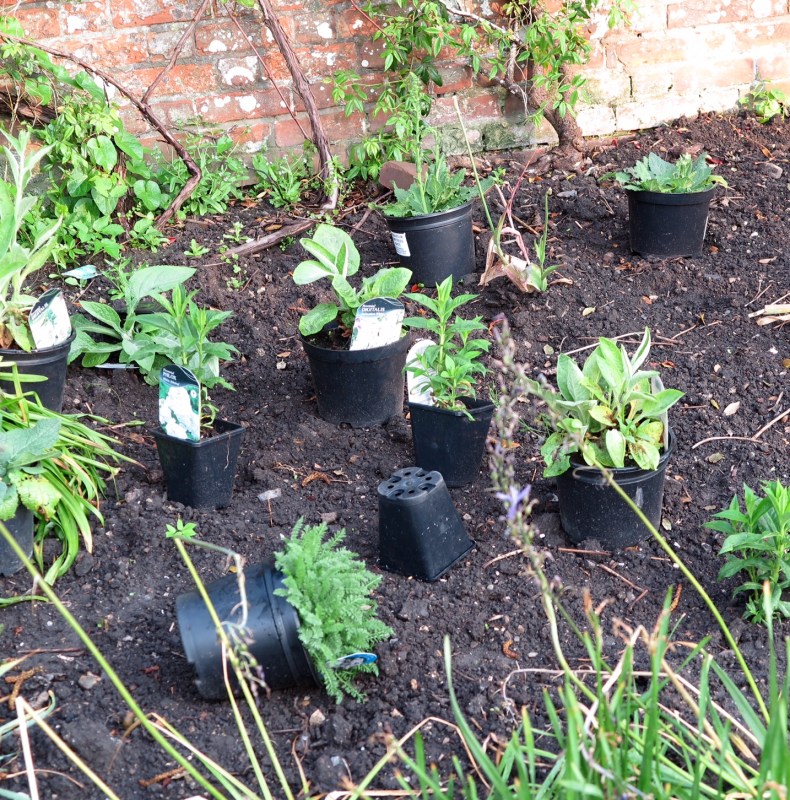
These plants are all still in their pots. This is the point at which Posy warned me not to have the phlox in front of the verbascum, so I swapped them round.
Dig a hole that is slightly larger than their roots.
Garden author and expert Sarah Raven teases out the roots of plants – or even tears a few tendrils away – so that the plant doesn’t go in with all the roots curling round in its pot shape.
Add some compost or fertiliser to the hole. Then add the plant, firm up the soil around it and water well, soaking the soil rather than the leaves of the plant.
Water well until plants are established. If you have a dry spell or a dry summer, you’ll need to water new plants regularly for the whole season.
9) Look after your soil
Professional gardeners always start by looking after their soil. They add a layer of compost at least once a year. You don’t have to dig it in, just let it lie on top. The worms and the micro-organisms will dig it in for you.
Here’s an easy guide to making your own compost.
It’s difficult to make enough compost for your garden yourself. So you can also buy well rotted manure or a straw based mulch called Strulch. (Note that links to Amazon are affiliate, see disclosure).
But if a border is crowded or they are growing high energy plants like roses, professionals often add extra fertiliser directly around the root of the plant. For roses add a slow release rose feed, such as Toprose or Vitax Organic Rose Food in spring and again at the end of summer.
If you fill gaps between your perennials with annuals, then they’ll be growing fast and needing extra. Try a weekly liquid seaweed feed, such as Envii Seafeed Extra or Doff Liquid Seaweed Extract .
I don’t think there’s any need to scatter all purpose fertiliser across your borders. Just add a layer of compost or mulch once a year and feed the plants that need extra directly around their roots.
10) What is the best time to plant a border?
Autumn and spring are the best times to plant a border.
But the beauty of container-grown plants is that you can plant many of them in the summer as well. If you are planting your border in the summer, make sure that you water it regularly. Your new plants won’t have established their root systems yet.
It’s not generally a good idea to plant a border in the winter. The soil may be too wet or cold. See the very best time to plant perennials for more tips from Henry Macaulay of top UK nursery, Marchants Hardy Plants.
More about how to plant a border
If you’re time-poor, and want a beautiful garden which doesn’t take too much looking after, see my post on brilliant low-maintenance plants.
And if you have a shady side of your garden, find out why the shady borders are often the easiest to look after and go on looking good for longer.
Add colour and structure when you plant a border by using perennials. And they’re much easier to look after than annuals. To find out more see Perennials Made Simple – how to choose and grow perennial plants. There are also some wonderful tips in What You Need to Know to Create an Outstanding Perennial Border.
Or see Alan Titchmarsh’s book How to Garden: Perennial Garden Plants.
If you love the abundant effect of a cottage garden, with loads of colour and texture, then consider self-seeding plants. My 25 best self-seeding plants add so much to my garden! And they’re very little trouble.
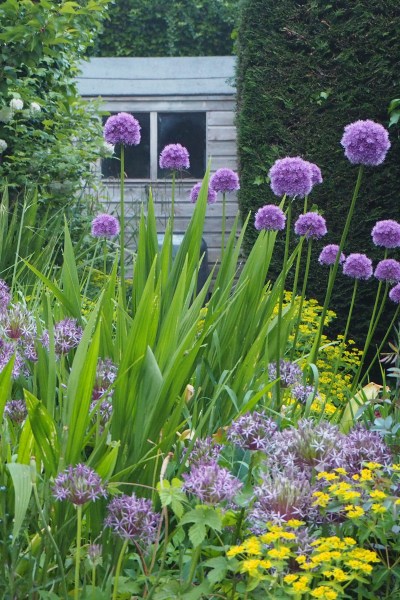
These alliums and euphorbia self-seed vigorously in our border.
And No Dig gardening can be another good way of saving effort in the garden. Here Charles Dowding explains why no dig is easy, weed-free and brilliant for flowers as well as for vegetables.
Join us every Sunday morning on the Middlesized Garden. See here to follow by email, and we will fly into your in-box when the sun comes up. And do share this, using the buttons below – thank you!
If you’re a beginner gardener….
Here are a few posts you should find useful. Start with getting to know the basics of gardening.
Then, because gardening can be expensive, check out how to save money when gardening.
One of the most useful plant groups are perennials. But people can get confused about them, so I’d recommend reading Perennials Made Simple.
And if you feel your garden is an important part of supporting wildlife and the environment, see my top wildlife friendly garden tips.
And if you’d like know what I wish I’d known when I started gardening, see the 5 top garden tips here.
Above all, take it a step at a time. Gardens and nature are very forgiving. And read this if you start feeling overwhelmed by your garden.
Shop my favourite garden tools, books and products…
I’m often asked for recommendations of good garden tools, books and more. So I’ve organised the products I use and the books I’ve read into easy lists on The Middlesized Garden Amazon storefront.
For example, in terms of choosing colour for your border, my two favourite books are Sarah Raven’s The Bold and Brilliant Garden and Christopher Lloyd’s Colour for Adventurous Gardeners. I’ve read them both over and over again, and they are always on hand. So they are both in my list of ‘Best Gardening Books’ on the Middlesized Garden Amazon store.
Pin to remember border planting ideas:
And if you’d like more tips, ideas and inspiration for your garden, enter your email to get a new post once a week. It’s free. You can unsubscribe at any time and we’ll never share your details with anyone!
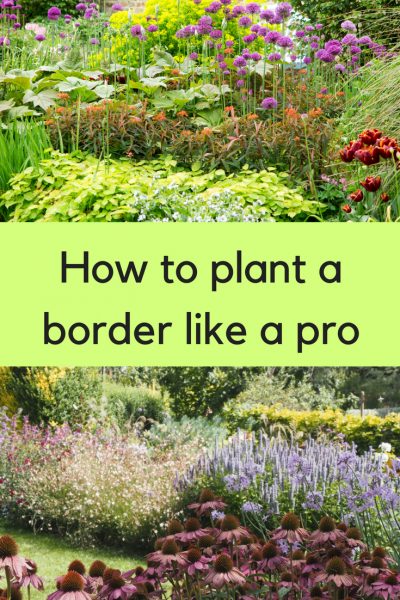























Hello, I’m a novice gardener and over the last year I planted up my border slowly. Someone came over to have a look at it and said that my plants are too far away from the front of the border and should spill over the edges. I’m in Glasgow. What should I be doing to correct this? I’ve planted roses and hardy geraniums. Can you recommend plants that will soften the front of the border? Should I be moving the plants I have further forward?
You could add some extra plants – it’s worth remembering that the garden is there for you to enjoy, so if you like the way you’ve planted it, then that’s all you need to know. But you don’t get so many weeds if you cover all the earth with plants. Hardy geraniums are good for a border, so you could plant some more and heucheras also have very pretty leaves in lots of colours. They make great border edging without flopping over too much.
Hi, I’m new to gardening and have followed your blog for some time. You mention that addition of self-seeding plants are good in a cottage border. Was wondering if this would be a problem if we have a smallish front garden (5m x 4m), would my self-seeding plants invade their well maintained plots or be a nuisance for them? There is only a small fence with my neighbour on one side. Thanks
Many plants are potentially self seeding or spreaders, so whether they spread to your neighbour’s garden depends on how much weeding your neighbour does rather than which plants you choose. If your neighbours have well maintained plots, they will be constantly weeding out any plants they don’t want, and those won’t always come from your garden – they are often blown in on the wind from several houses away or seeds dropped by birds. Just cut back anything that you can actually see straying over the fence and into their gardens – a climber, for example. Hope that helps.
Thank you very much for the response Alexandra. I was putting off trying some wildflowers in a small section of the front garden in case they did spread too much. I couldn’t gauge from other websites the extent and speed of spreading that a plant like Mexican Fleabane or Cosmos would achieve. But I will give it a go in Spring. Thanks again.
Hope it all goes well!
Don’t ever be put off trying something new. If it doesn’t work, you can take it out. Sometimes taking a punt works; sometimes it doesn’t. Be brave. BTW, cosmos is never invasive in my experience. Most garden plants are compliant, excepting perhaps pampas grass!
I agree!
Thank you for all of this great advice! Planning my first border garden and this was very helpful! I was wondering, could you please tell me what type of tree you have in the back of the penstemon photo?? It’s so gorgeous!
I’m fairly sure you’re referring to the dark red Cotinus coggyria ‘Grace’ or smoke bush. It is gorgeous, but getting old so every year we’re never sure if it’s going to come back.
I always just sort by height order, which might be a bit boring ant not very professional looking but has the advantage of being simple and logical. I get frustrated though that the height quoted on websites like the RHS normally seem to include things like the flowering stems, which are temporary and don’t block light much normally anyway. The only reason I want to know the height is to make sure each plant doesn’t overshadow its neighbours too much, so for me the numbers quoted aren’t helpful.
Good point – the height given on the label isn’t always that much of a help
Thanks Alexandra, I really enjoyed this post! I hadn’t thought about density of plants at the front of a border. I was just thinking about mixing in some nicotiana and fennel and think I might reverse them so the fennel is at the front rather than behind so I don’t get a block from the nicotiana. So, good timing thank you!
Thank you – not my intel, of course, but Posy’s – she’s very good at looking at a border and seeing what works and why. Nicotiana and fennel sound heavenly together.
Very encouraging to us novice gardeners to see that even the experts sometimes have to replace or discard plants that just aren’t working in particular positions. Love the zinnias and the acanthus with white foxgloves. I planted assorted tulips (supposedly a mixture of mauve and blackish-red) only to find, annoyingly that quite a few were rather gaudy striped red and yellow – is colour-blind planting ever acceptable?!
That’s always so annoying, if amusing – if you bought them from a tulip supplier, you could complain to them…on the other hand, cheery mistakes are always so heart-warming for everyone whose tulips did come out the colour they thought they’d be (are there any such perfect beings?).
I am struggling with planting and so it was good to be reminded that Show Gardens are just that and my ‘mistakes’ are ‘normal’. Thank you.
A pleasure. Thank you for commenting.